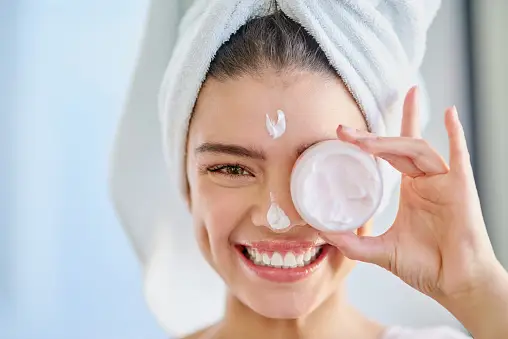Regarding skincare, the sequence in which I apply my treatments may make all the difference. Trust me; I have spent a lot of time looking into and testing to find the ideal Order of skincare routine to get that healthy, radiant complexion everyone wants. From dawn to night, I will walk you through all that I do in this post for keeping my skin looking its best.
Understanding the Importance Order Of Skincare Routine
I didn't know at first that the order in which I applied goods is just as crucial as the products itself when I started my skincare journey. Following the right "skincare routine order morning and night" guarantees that every product may perform as expected, therefore optimising the advantages for my skin.
Basic morning routine
- Cleanser: Use it to get rid of overnight accumulated filth and residue.
- Moisturizer: This moisturises the skin and may be found in balms, creams, or gel form.
- Sunscreen: It's crucial to shield the skin from the harmful UV rays.
Step 1: Oil-based cleanser
- What is it? Two types of cleansers are water- and oil-based ones. The later breaks down oils your skin generates.
- How to use it: While some oil-based cleansers are ideal for dry skin, others perform better on moist skin. Before putting a tiny bit on, read the directions. Massage in and rinse well with water; then, dry with a fresh towel.
- Skip this step if:If you have combination or oily skin, your cleanser just includes oil rather than a mix of oil, surfactants, and emulsifiers. Cleansing agents could make oilier.
Pros:
Trusted Source says that oil cleansers offer more cleaning power. They can clear pores and take off waterproof makeup. A little 2019 study Trusted Source indicates oil cleansers could remove waterproof sunscreen more effectively than other techniques. Visit our dedicated Beauty hub here.
Cons:
According to anecdotal data, you can have an initial 1-to 2-week "purging" period during which old oil on your skin is cleared and outbreaks could result.

Step 2: Water-based cleanser
- What is it? Usually include surfactants, these cleansers let water wash away perspiration and debris. They can also get rid of oils gathered using an oil-based cleaning.
- How to use it: After massaging into damp skin, rinse with water and pat dry.
- Skip this step if: If the surfactants in your oil-based cleanser are strong enough to get rid of dirt and debris, you don't need to undertake a second cleansing.
- Be sure to: Seek for a cleaner with a pH of neutral, according to a 2021 research. According to Trusted Source, they might not irritate your skin as much.
Pros:
Oily or acne-prone skin types may benefit from using gentle water-based cleansers to avoid outbreaks.
Cons:
Stronger surfactants have the potential to dry out and harm your skin's natural barrier.
Read also: 5 Minute Crafts Beauty Hacks For Face
Step 3: Toner or astringent
- What is it? Toners remove debris and dead cells from the skin after cleaning while also hydrating the skin. An alcohol-based substance called an astringent is used to get rid of excess oil.
- How to use it: Immediately after washing, use a cotton pad or tap straight onto the skin, swiping the face outward.
- Skip the astringent if: Your skin is dry.
- Be sure to: Stay away from alcohol-based toners since they may cause skin irritation.
Pros:
After washing, contaminants left behind may be eliminated and pores can be less noticeable with the use of toners and astringents.
Cons:
Using alcohol-based toners excessively might irritate skin.
Step 4: Antioxidant serum
- What is it? Certain chemicals are concentrated to a great degree in serums. A serum with antioxidants shields skin from harm from unstable molecules known as free
radicals. Common antioxidants used to enhance smoothness and hardness include vitamins C and E. - How to use it: Apply a few of drops to your neck and face.
- Be sure to: To evaluate how a new product interacts with the other items in your regimen and on your skin, test it first on a tiny area of your skin.
Pros:
Serums including antioxidants help lessen wrinkles, redness, and skin damage.
Cons:
Certain serums, such those with acids, could irritate your skin if you use them with other skin care products that also include acids.
Read also: Eye Makeup Tutorials For Green Eyes
Step 5: Spot treatment
- What is it? If you have a head blemish, use an anti-inflammatory medication to get rid of it first, and then use a spot-drying treatment to get rid of the remaining mess. Cysts are anything under the skin, and you will need to use a treatment that fights the infection from the inside out.
- How to use it: To get rid of any skin care products from the area, use a moist cotton swab. After using a tiny bit of the therapy, let it dry.
- Skip this step if: You want to let nature take its course, or you don't have any spots.
- Be sure to: Spot treatment should not be applied to visible flaws.
Pros:
Treatments for acne can lessen discomfort, redness, and inflammation.
Cons:
Skin responses are possible, particularly with products with more potent chemicals. Always start a new product gradually and keep an eye on your skin.

Step 6: Eye cream
- What is it? The skin that surrounds your eyes is often more sensitive and thinner than the rest of your face. Additionally, it is prone to aging symptoms including puffiness, discoloration, and fine wrinkles. An effective eye cream can brighten, smooth, and firm up the area, but it won’t completely eliminate issues.
- How to use it: Apply a tiny quantity to the eye region with your ring finger.
- Skip this step if: Your serum and moisturizer are fragrance-free, have a potent composition, and are appropriate for the eye region.
- Be sure to: Use sparingly and make sure to thoroughly clean. If product accumulation is left in this delicate region, it might block pores.
Pros:
Specifically designed eye treatments for the sensitive skin around your eyes can help reduce wrinkles and discoloration, two classic signs of aging.
Cons:
Getting your eye cream into your eyes might irritate them.
Read also: Why Does My Makeup Look Oily After A Few Hours
Step 7: Moisturizer
- What is it? A moisturizer soothes and softens skin. Apply a lotion or balm on dry skin. Thickner creams are ideal for normal to mixed skin types; fluids and gels are advised for oilier skin types. Examples of chemicals that are effective include glycerine, ceramides, antioxidants, and peptides.
- How to use it: A bit little bigger than a pea should be warmed in your palms. Apply in upward strokes, starting on the cheekbones and working your way down the face.
- Skip this step if: Your toner or serum provides you with enough hydration.
- Be sure to:Use clean hands to apply moisturizer, especially if you're applying it from a container that you dip your fingers into. You might be introducing bacteria and grime to your moisturizer if you use unclean hands.
Pros:
Regular moisture helps prevent acne and other skin issues by protecting the skin barrier.
Cons:
Milia, or little white pimples, can appear if you use an excessively thick moisturizer without first washing your skin.
Read also: Women's Beauty Tips And Tricks: Expert Secrets
My Night time Skincare Routine
My attention turns to skin restoration and repair at night. The skin care routine steps night are a little different since I use products that are most effective when applied when I'm asleep.
Basic evening routine
- Makeup remover: It does what it says on the tin, even removing the makeup residue you can’t see.
- Cleanser: This will get rid of any lingering dirt.
- Spot treatment: At night breakouts can be treated with soothing and drying treatments.
- Night cream or sleep mask: Repairing damaged skin is easier with a thicker moisturizer.
Step 1: Oil-based makeup remover
- What is it? You may remove both your skin's natural oils and any greasy makeup using an oil-based cleanser.
- How to use it: Makeup remover can be used on either damp or dry skin, depending on their recommendation. After applying, massage into skin until thoroughly cleansed, and then wash off with water.
- Skip this step if: You don’t wear makeup, have oily skin, or would prefer to use a water-based product.
- Be sure to: Read the instructions on your oil-based makeup remover, as some may direct you to follow this step with another type of cleanser or micellar water to remove residue.
Pros:
By using a makeup remover, you may assist eliminate impurities and residue from your skin that are caused by makeup.
Cons:
Skin pores can get clogged if excess oil is not completely removed from the skin.

Step 2: Water-based cleanser
- What is it? Cleansers that are based in water react with dirt and makeup that is already on the skin, which makes it easy to remove everything entirely with a simple water wash.
- How to use it: Observe the guidelines. In most cases, you will massage it into skin that is moist, and then you will rinse it off.
- Skip this step if: You shouldn't double cleanse.
- Be sure to: Pick a mild recipe with an alkaline pH. These support the integrity of the natural barrier that covers your skin. Excessive force might cause skin irritation.
Pros:
Removing any residue from your oil cleanser or makeup remover might be aided by double cleaning.
Cons:
Certain formulae could contain chemicals that cause skin irritation. Try a different product if you start to feel irritated or dry.
Read also: 10 Beauty Hacks How To Grow Your Nails Overnight With Vaseline
Step 3: Exfoliator or clay mask
- What is it? Exfoliation clears pores and gets rid of dead skin cells.Clay masks can absorb extra oil in addition to clearing clogged pores. To help the skin absorb additional products and eliminate any remaining debris, these masks work best when worn at night.
- How to use it: Exfoliators require varied application techniques, so read the product manual carefully. Apply clay masks to your entire face or to particular trouble spots once or twice a week. After the suggested amount of time, remove it with a warm water rinse and pat dry.
- Skip exfoliating if: Already, your skin is inflamed.
- Be sure to: Refrain from using chemical and manual exfoliators excessively, particularly if your skin is sensitive. If irritation occurs, stop using. After exfoliating, make sure to apply sunscreen during the day because exfoliators may make you more sensitive to the sun.
Pros:
Dead skin cells are removed from your skin's surface by exfoliation. In addition to removing impurities from deeper inside your skin, certain chemical exfoliators help stop outbreaks.
Cons:
Certain physical exfoliators, such those with salt or grainy sugar, can irritate and abrade delicate skin. Once your skin has recovered, discontinue using the cream and replace it with another if it irritates your skin.
Step 4: Hydrating mist or toner
- What is it? You may conclude your overnight washing procedure with a moisturizing spray or toner. To add moisture to skin, look for humectant substances like glycerine, lactic acid, and hyaluronic acid.
- How to use it: Apply spritzes on your face. Use a cotton pad to apply the toner product and then swipe it over your skin.
- Be sure to: Toners with high alcohol content should not be used excessively as they may irritate your skin or harm its protective layer.
Pros:
Toners can help balance the pH of your skin and get rid of residue left over from previous steps in your process.
Cons:
Products with alcohol content may irritate those with sensitive skin.
Step 5: Acid treatment
- What is it? Treatments with facial acids may promote cell turnover. Novices might wish to give glycolic acid a try. Additional choices include hydrating hyaluronic acid and salicylic acid, which fight acne. Your complexion should become more even and brighter over time.
- How to use it: With the intention of using it every night, begin once a week. Patch testing should be done at least 24 hours before usage. Using a cotton pad, apply a few drops of the solution and gently wipe over the face, being careful around the eyes.
- Skip this step if: You react badly to a certain acid or have extremely sensitive skin.
- Be sure to: Select an acid treatment based on the requirements of your skin.
Pros:
Research from 2021 indicates that acids can help balance out your skin tone and lessen acne, wrinkles, scars, and fine lines.
Cons:
Your skin may become more sunsensitive if you consume acids. Make careful to use sunscreen during the day after using an acid treatment.
Read also: Sensitive Skin Care Routine At Home Gentle and Effective Way
Step 6: Serums and essences
- What is it? Strong chemicals are applied topically to the skin using serums. A simplified form is called an essence.While antioxidants like green tea extract might aid with dull complexions, vitamin E is wonderful for dry skin. If you often break out, consider taking vitamin C or retinol.
- How to use it: Do a patch test the day before you want to use a new essence or serum. Press the product into your skin with your palm if your skin appears nice. It is possible to stack different items. Simply apply the water-based ones first, followed by the oil-based ones, and let them around 30 seconds to dry.
- Be sure to: Select a serum that offers the anti-aging, hydrating, brightening, or spot-reducing properties your skin requires.
Pros:
Highly concentrated skin benefits are provided by serums. Their formula type allows more of the substance to seep through to the surface of your skin.
Cons:
While certain serums might be expensive, there are typically less expensive options available. Furthermore keep in mind that you need far less serum than moisturizer—a little goes a long way.
Step 7: Spot treatment
- What is it? Apply a spot-drying treatment afterwards. Dry spots are great to use at night.
- to use it: Make sure you have clean skin. Use a tiny bit of the product, then let it dry.
- Skip this step if: You're perfect.
- Be sure to: Refrain from popping zits, pimples, and whiteheads on your own. According to the AAD, this can push pus further beneath the skin, introduce germs, and leave scars. Consult a dermatologist if, after four to six weeks, you still don't observe any change.
Pros:
Products for healing can sometimes even show results immediately.
Cons:
It is possible to have redness, irritation, or peeling, particularly if your skin is sensitive.
Read also: 6 Best Makeup Colors For Blue-Green Eyes
Step 8: Hydrating serum or mask
- What is it? Serums for hydrating introduce moisture without blocking pores.
- How to use it: There are several forms for these strong hydrators. There are serums, heavier masks, and some that you may leave on overnight. If so, use it at the conclusion of your workout. Just do as advised on the pack.
- Be sure to: Refrigerate a sheet mask before applying it to get some extra anti-inflammatory effects.
Pros:
A mask may eliminate extra sebum and maintains good and moisturizing substances near to your skin.
Cons:
Test masks on a tiny patch of skin before using, as they may have components that aggravate your skin as with other new skin care products.
Skincare Routine Order for Acne

Dealing with acne can be frustrating, but I’ve found that following the right order of skincare routine for acne can make a significant difference. Here’s what I do to keep my skin clear:
- Cleanser: I start with a mild, non-comedogenic cleanser not likely to clog my pores.
- Toner: Salicylic acid in a toner aids to prevent fresh breakouts and assist to further cleanse my pores.
- Acne Treatment: I treat acne immediately on any affected areas with either tea tree oil or benzoyl peroxide.
- Serum: Redness is lowered and inflammation is calmed by a lightweight, oil-free serum using niacinamide.
- Moisturizer: I have skin prone to acne, hence moisturizing is still rather important. I hydrate without aggravating breakouts with a non-greasy moisturizer.
- Sunscreen: I never miss sunscreen during the day as many acne medications might increase UV sensitivity of my skin.
Skincare Routine Order for Beginners
When I first started taking skincare seriously, I found it overwhelming with all the products and steps involved. If you’re just starting out, here’s a skincare routine order for beginners that’s simple and effective:
- Cleanser: Start with a simple cleanser meant for your skin type.
- Moisturizer: Keep it basic with a decent moisturizer that nourishes and moisturizes your skin.
- Sunscreen: Finish your day with sunscreen to guard against UV damage to your skin.
As you get more comfortable with these basics, you can gradually add other steps like serums or toners, depending on your skin’s needs.
Read also: 12 Beautiful Trending Cornrow Styles You Need to Try
Customizing My Daily Skincare Routine at Home
Skincare is one of the things I enjoy as I may change my Daily skincare routine at home to meet my particular demands and way of life. I personalize my regimen in this way:
- Morning: Protection—cleansing, toning, hydration, and sunscreen—is what I pay most attention to.
- Night: Treatment and repair—cleansing, treating, and moisturizing—take front stage here.
Whether I’m dealing with dryness, acne, or just want glowing skin, I adjust my routine by switching up products or adding extra steps like masks or oils.
Bottom line
My skin's health and look have much improved by using these guidelines and keeping to a regular schedule. Knowing the order of skincare routine will help you either new to skincare or trying to improve your current regimen. Recall that the key is to be patient with the process and to discover what suits you best!
FAQs' Order Of Skincare Routine
What are the 7 steps of skincare?
- Step 1: Cleanser. The first step to your skincare routine is always cleansing.
- Step 2: Toner/Astringent.
- Step 3: Masks / Exfoliator.
- Step 4: Serum.
- Step 5: Moisturizer.
- Step 6: Eye Treatment.
- Step 7: Primer + Makeup.
What is the order of skincare routine?
- 1 Step Cleansing.
- 2 Step Exfoliation.
- 3 Step Mask.
- 4 Step Toner.
- 5 Step Serum or concentrate.
- 6 Step Eye contour.
Should I use retinol or hyaluronic acid first?
In case of dry or sensitive skin, hyaluronic acid should be stacked before retinol as it forms a barrier between retinol and your skin, therefore balancing irritation. Must-mention: let your hyaluronic acid serum dry; then, apply retinol as, on moist skin, this increases the danger of redness and dryness.
Do you put serum or toner first?
For best absorption into the skin, for instance, apply a toner shortly before a serum. Alternatively, nightly use retinol to prevent photosensitivity.
What is the 4 2 4 rule in skincare?
The 4-2-4 technique consists in four minutes of rubbing your face with a cleaning oil, two minutes with a water-based cleanser (ideally creamy), then two minutes of rinsing with warm water and two with cold water." Ideally, the 4-2-4 technique should be done before bed.








